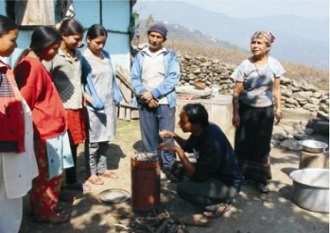Poorly ventilated small fires are claiming millions of lives – as wood for them wrecks the environment
Madeleine Bunting – guardian.co.uk, 21 September 2010
Hillary Clinton is expected to pledge $50m to help suppply 100m fuel-efficient stoves to Africa. One of the most powerful women in the world is talking about cooking stoves. Thank God. Today, Hillary Clinton will describe the huge impact that something as simple as cooking fuel has on millions of lives. Want to know what is one of the leading causes of death for women and small children? You might imagine HIV/Aids or, given the focus on maternal mortality at the UN Summit in New York, you might suggest that women’s greatest risk is death in childbirth. But just as dangerous and much less well publicised is the risk of inhaling smoke from cooking on open fires which leads to lung and heart diseases. According to the United Nations, smoke costs 1.9 million lives a year.
Think about it; every day, millions of women across Africa and India spend several hours crouched over small fires cooking. Often their homes have no chimneys and poor ventilation. This daily proximity destroys lungs. Small children staying close to their mothers are equally vulnerable. Finally, this huge story is percolating through to the mainstream. Clinton is due to announce $50m (£32m) in seed money to the Global Alliance for Clean Cookstoves, to supply 100m fuel-efficient stoves across Africa.
What makes this situation so frustrating is that it is as destructive of the environment as it is of human tissue. In many countries, chopping trees for firewood is leading to long-term environmental degradation. When I visited western Uganda, the results were shockingly evident. The beautiful hills are now largely stripped bare of trees, much of the deforestation has occurred in the last 50 years, and the results are long run-off scars across the hills where rain has washed the soil away. Further environmental damage is done by the tons of soot spewed into the atmosphere, contributing to global warming.
Clean, sustainable energy supplies are going to become a crisis issue across eastern Africa. The pace of deforestation and population growth is such that experts predict that within 25 years, supplies of firewood – the main source of cooking fuel – will have largely run out. Given that the staple foodstuffs of these African countries require cooking (for example millet, sorghum), the impact on nutrition and hunger will be huge. And fuel impacts on women’s lives in other ways; as the supplies become more scarce, they have to walk further and further to collect what they need, as the collecting of firewood is a woman’s task. In places of conflict such as Darfur or Congo, it is collecting firewood which exposes women and children to the risk of rape.
This is a problem that does not require expensive technology. It is about using fuel efficiently. Watch this video by one manufacturer of clean stoves in China now exporting to Africa. We know exactly how to make these stoves at relatively low cost. The challenge is to distribute them fast enough to pre-empt the kind of crisis predicted for east Africa. One really interesting possibility is linking clean stoves to microfinance schemes enabling small local businesses to develop who will be able to sell the stoves. Millions are needed, and there is no time to waste.
Aid follows fashions – over the last few years millions of malaria nets have been flooding in to Africa with dramatic results – hopefully Clinton’s initiative will set a new trend. And this is a subject that people ought to really get behind in the way that the Alliance for Safe Motherhood has mobilised campaigners on maternal mortality. Stoves are a feminist issue – where are you Mumsnet?



